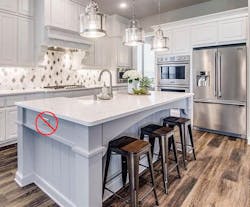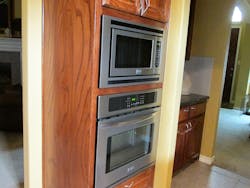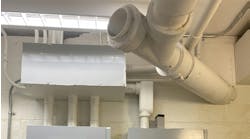The kitchen of a home is more than just a place to prepare food. It’s a place for the family to gather and share meals, discuss and celebrate life events, and entertain family and friends. Second only to bathrooms, the kitchen is also the most dangerous room in the home. Some of the hazards found in kitchens are rather obvious, including knives, exposed elements on cooktops and ranges, tile floors that can be slippery when wet, and so forth. Other hazards are less obvious but can be just as (if not more) dangerous to family members and other guests in the kitchen. These are the electrical hazards that go unnoticed by most people.
NFPA 70 (NEC) Code-Making Panel 2 (CMP 2) has worked for many years to address and reduce electrical hazards in kitchens. The group took a major step forward with the 2023 National Electrical Code (NEC). In this article, we will review the changes to the NEC designed to make the kitchen a much safer place.
Electrical appliance cords
Electrical appliance cords routed over the edge of the countertop to access a receptacle outlet installed below the countertop are one such hazard. Since the 1990 NEC, a receptacle outlet(s) has been required to serve each island or peninsular kitchen countertop over 12 in. wide in kitchen and dining areas. As there is generally no wall or backsplash on or in which to install a receptacle, permission to install a receptacle in the side wall of the peninsular or island countertop base (and within 12 in. of the top) has been provided in Sec. 210.52(C)(3). There have been many objections to this permission for side mounting of receptacle outlets with fear that cords hanging over the countertop may be inadvertently pulled or snagged. Appliances — such as fryers and crock pots containing extremely hot liquids that may contact persons (including small children who may pull cords) — have been of concern to many. Until recently, these concerns have been mostly anecdotal.
A task group appointed by the Chair of CMP 2 charged with obtaining the number of documented injuries from pulling an appliance cord yielded startling results. As per the Consumer Product Safety Commission, nearly 10,000 hospital visits are estimated to have occurred from such events. This number included some fatalities. With the evidence no longer being primarily anecdotal, CMP 2 acted. Receptacles per Sec. 210.52(C) are no longer required to serve island and peninsular kitchen countertops. If a receptacle is to be installed to serve such tops, it may not be installed on the side of the cabinet base. A type of receptacle assembly commonly referred to as a pop-up or other type permitted to be installed in the countertop surface must be used, meaning our kitchens just got safer.
GFCI protection
Beginning with the 1987 NEC, ground-fault circuit-interrupter (GFCI) protection was introduced for dwelling unit kitchens. The initial requirement was for GFCI protection of countertop receptacles within 6 ft of a sink. The expansion of this life-saving protection has steadily progressed ever since.
Kitchens are electrically more complicated today than ever before. An original premise of GFCI protection for kitchen receptacles was to provide a level of protection from the use of electrically operated appliances and equipment near the kitchen sink. Dropping an appliance into the sink or contacting the sink while operating an appliance was the fear. Such an appliance that may be leaking dangerous levels of current could put the user in great danger. Documented cases of electrocution while using such equipment supplied by non-GFCI outlets are abundant. Unfortunately, these cases of severe electrical shock injury and electrocution at non-GFCI-protected outlets are still occurring.
The progression of GFCI protection in kitchens has moved beyond concerns of just contacting the sink while operating an appliance. Large conductive surfaces of appliances that one may contact while operating an appliance, standing on a conductive tile floor, contacting another appliance, or any combination thereof pose at least an equal risk.
Accordingly, in the furtherance of making kitchens more electrically safe than ever before, Sec. 210.8(A)(6) requires all 125V through 250V single-phase receptacles up to 50A to be GFCI protected. No more measuring formulas or concerns with doors and types of doors — simply all the receptacles in the kitchen shall be GFCI protected. This is essentially the same rule we have had for commercial kitchens since the 2002 NEC. Additionally, GFCI protection shall be provided for the branch circuit or outlet supplying the appliances listed in Sec. 210.8(D). Large conductive surfaces for these appliances may pose a risk of electrical leakage current above the levels considered safe for human contact, and GFCI protection will serve to mitigate these risks.
Conclusion
This consistent progression of safety will undoubtedly make kitchens safer for us, our families and anyone working in or visiting our homes. This progression may well lead to the point where kitchens are no longer the second most dangerous room in the home but electrically as safe as any other room in the dwelling.
David Humphrey is certified as a 1&2 Family, General Electrical Inspector, Electrical Plans Examiner, and he holds a Virginia Master Electrician’s certification. He currently serves as an electrical plan review engineer. He can be reached at [email protected].
Inspector Intel articles are provided by the International Association of Electrical Inspectors (IAEI), www.iaei.org, a membership-driven, non-profit association headquartered in Richardson, Texas, that promotes electrical safety throughout the industry by providing education, certification of inspectors, advocacy, partnerships, and expert leadership in electrical codes and standards.







